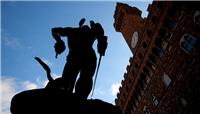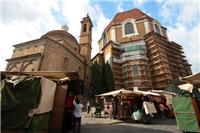Florence is one of the preeminent cities for art with such a wealth of museums that it would be almost impossible to list them all. Some of the most precious artwork in the world can be found in the city and many of the most important artists have lived or worked in Florence. Over 300,000 works are on display in the city, covering everything from prehistory to the 20th century. The most noted masterpieces however are generally those pertaining to the Florentine Renaissance, perhaps the most glorious period of art in Western culture.

A tour of the museums can be highly personalized according to your interests and may include any specific preferences for paintings, sculpture, historical and architectural works, modern art, traditional costumes, silver and porcelain, a particular artist, natural history, semi-precious stones or science.
We suggest that any art tour include at least the Uffizi Gallery, the Vasari Corridor (although it is not always possible to visit) and the Medici Chapels.
Uffizi Gallery
It was built in 1560 by the architect, Georgio Vasari, who was commissioned by Cosimo I of the Medicis to construct a huge palace with two wings overlooking the river, which was intended to accommodate the Florentine state's administrative and legal offices. A great debt is also owed to Vasari for his subsequent construction of an overhead corridor which goes over the Ponte Vecchio and joins the Uffizi Gallery with what would become the Medicis' new residence, the Palazzo Pitti.
The museum is home to a fabulous artistic legacy made up of thousands of paintings that cover all different periods, from medieval to contemporary works, including a large number of centuries-old sculptures, miniature paintings and tapestries. The early Medici collections make up the Gallery's original core body of works, but the family's strong dedication as patrons of the arts caused it to grow beyond all expectations during the time of their reign. The wedding presents and inheritance received as part of the many illustrious matches made by some members of the family also contributed to the expansion of this great artistic heritage.
The Medicis were friends and promoters to such famous Renaissance artists as Botticelli, Michelangelo and Raphael, to name just a few, and some of their most beautiful and well-known works can be admired in the Gallery.
Tickets and reservations required.

Vasari Corridor
The Corridor was constructed in 1567 by Vasari who was under a commission from Cosimo I de Medici to join together the Uffizi Gallery and the Palazzo Pitti, the Medicis' residence. The elevated structure is around a kilometer long and starts from the Uffizi Gallery, heads towards the Ponte Vecchio and over to the other side of the Arno River where it reaches the Palazzo Pitti. The design of an "aerial" passage that allowed the head of state to reach their offices privately is extremely novel from an architectural point of view and it also allows for a spectacular view of the city and the river. It is possible to see the interior of the Chiesa di Santa Felicita from the Corridor, just as the Medicis did when they watched religious services from their own private box.
Today, the Vasari Corridor houses part of the Uffizi's collection of 17th and 18th century paintings and the very interesting and significant self-portraits section. Access to the Corridor, which is only open to visits certain days of the week, is restricted to small groups and tickets and reservations are required.

The Medici Chapels
The chapels make up a vast ensemble of different items of major interest. The huge crypt, designed by the architect Buontalenti, contains the burial vaults of the Medici family while the underground areas house only the very dramatic tomb of Cosimo I and the final resting place of Donatello.
The tombs of the family's grand dukes can be found in the sumptuous Princes' Chapel and are decorated with majestic statues of gilded bronze. A corridor connects this chapel to the New Sacristy (so-called to differentiate it from Brunelleschi's), which was conceived as a funerary chapel in keeping with the visions of Cardinal Giulio de Medici and Pope Leo X. Michelangelo started the construction of the New Sacristy in 1521, but the expulsion of the Medicis in 1527 considerably slowed down the work. The definitive departure of Michelangelo in 1534 meant that his work was never completed.
Tickets and reservations required.